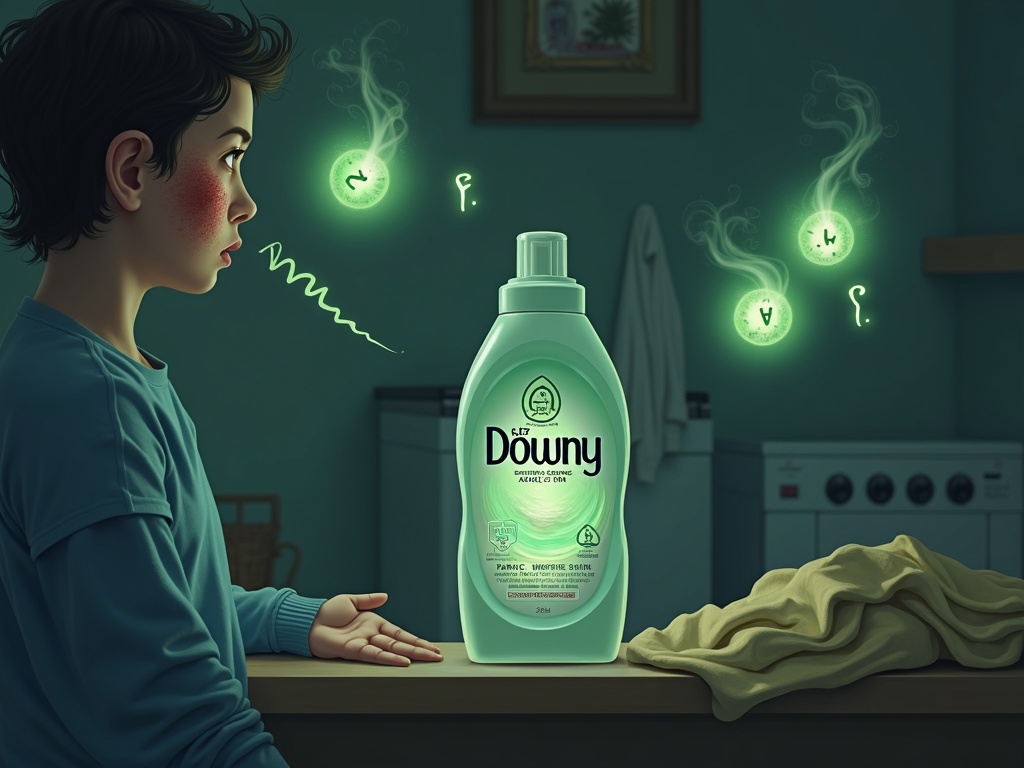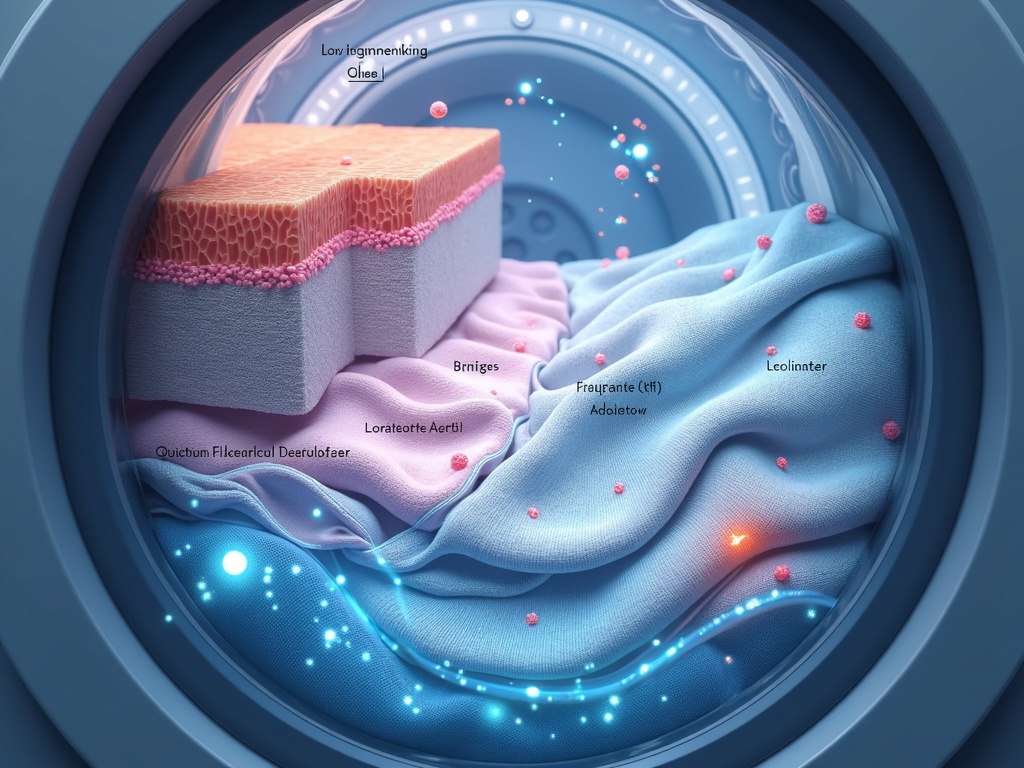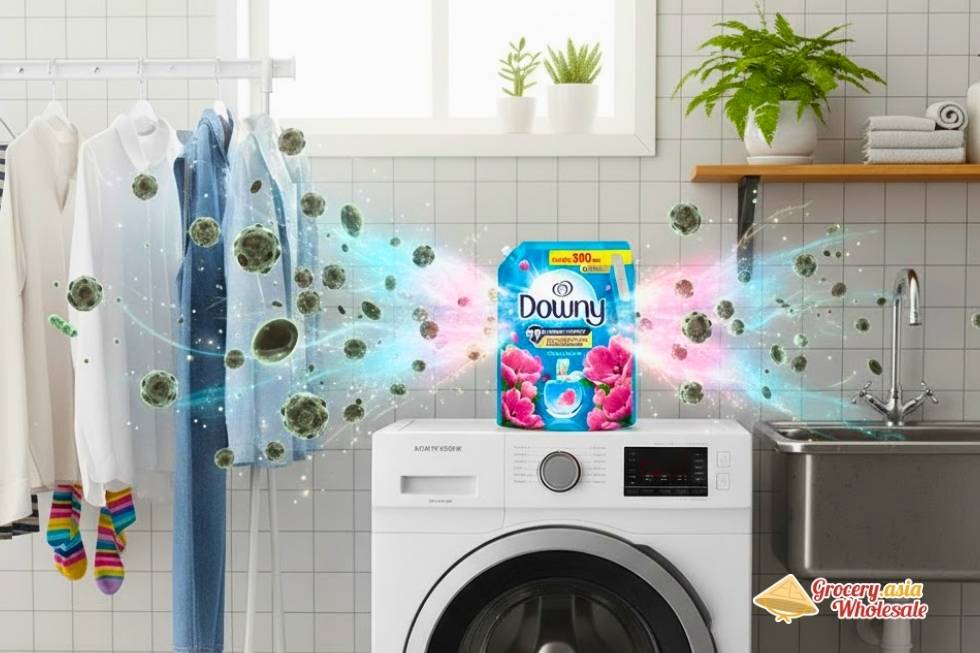No products in the cart.
Downy Fabric Softener, Fabric Conditioner, Home Care
Is Downy Fabric Softener Toxic For Sensitive Skin
Downy fabric softeners may pose health risks for individuals with sensitive skin due to their chemical composition, including synthetic fragrances and quaternary ammonium compounds.
Table of Contents
Risks Associated with Downy Fabric Softeners
Many fabric softeners, including various Downy products, contain chemical ingredients that can cause adverse skin reactions, particularly in people with heightened sensitivities. Among the most common culprits are quaternary ammonium compounds—often listed as “quats”—and synthetic fragrances, both of which are linked to skin and respiratory issues.
Quats are a group of surface-active agents used in fabric softeners to reduce static and add softness. However, they are known to cause allergic contact dermatitis in some users. Likewise, synthetic fragrance mixtures—often made up of dozens of undisclosed chemicals—are recognized as leading causes of allergic reactions, even in small concentrations.
Scientific Findings on Sensitivity and Safety Concerns
According to research, an estimated 1–4% of the population experiences allergic reactions to fragrance ingredients commonly found in household products like fabric softeners. In line with these findings, the Environmental Working Group (EWG) has assigned several Downy products “F” ratings for safety.
Reasons for Low EWG Ratings
- Respiratory risks: Some ingredients are linked to moderate to high concerns about respiratory tract irritation.
- Skin sensitization: Products contain compounds that pose a risk for allergic reactions among individuals with sensitive skin.
- Fragrance disclosures: In many cases, the complete fragrance list is proprietary, making it harder for consumers to identify harmful substances.
Residue and Daily Exposure
A hidden but significant concern is the continued exposure to these potentially irritating chemicals through residues embedded in clothing. Even after the fabric leaves the washer and dryer, chemical traces remain in fabric fibers and are absorbed through skin contact throughout the day.
Is Downy Free & Gentle a Safer Choice?
Downy markets its Free & Gentle line as being free of dyes and perfumes, making it appealing to users seeking allergen-free options. However, it still includes quaternary ammonium compounds, which may cause irritation in individuals with heightened chemical sensitivity, though at a reduced risk compared to fragranced varieties.
Safer, Natural Alternatives
For those looking to avoid synthetic additives, several natural options offer effective fabric softening without the health risks:
- White vinegar: Naturally softens clothes and neutralizes odors.
- Baking soda: Helps maintain pH balance and softens fabric.
- Wool dryer balls: Reduce static, speed up drying time, and are reusable alternatives to chemical softeners.
If you experience skin irritation or sensitivities, consider switching to these natural alternatives or thoroughly researching any fabric softeners you use through reliable resources like the EWG’s product database.
The Hidden Dangers of Downy Fabric Softener for Sensitive Skin
I’ve discovered concerning information about fabric softener ingredients that many consumers aren’t aware of. Fragrances in Downy rank among the top five most common causes of allergic contact dermatitis according to dermatological research. This fact alone should make anyone with sensitive skin think twice before using these products.
The statistics reveal a troubling reality. Between 1–4% of the population suffers from allergic reactions to fragrance ingredients, while many more experience mild irritation. Even if you haven’t noticed symptoms yet, repeated exposure can lead to sensitization over time.
Product Safety Ratings Expose Serious Concerns
The Environmental Working Group assigns several Downy products, including Downy Ultra Fabric Conditioner April Fresh, an “F” rating for ingredient safety. EWG identifies “high concern” for respiratory irritation and “some concern” for skin allergies and sensitization. These ratings come from extensive research into chemical safety and health impacts.
I often see people confused by marketing claims about fabric softener safety. The term “hypoallergenic” appears on many products, yet the FDA doesn’t regulate this claim. Companies can use this marketing term without standardized testing, making it essentially meaningless for protection.
Quaternary Ammonium Compounds, known as Quats, represent a key ingredient group in Downy formulations. These chemicals cause skin and respiratory irritation, particularly after prolonged exposure through clothing contact. Every time you wear freshly laundered clothes treated with these products, your skin absorbs small amounts of these potentially harmful substances.
The residue left on fabrics doesn’t simply wash away with time. These chemicals bind to textile fibers and release slowly, creating continuous exposure throughout the day. I’ve seen cases where people developed mysterious rashes or breathing difficulties that cleared up only after switching to gentler laundry products.
Parents should exercise special caution when considering fabric softener for children’s clothing. Young skin is more permeable and reactive than adult skin, making children more vulnerable to irritation and sensitization.
The combination of synthetic fragrances, preservatives, and chemical softening agents creates a cocktail of potential irritants. Even people without diagnosed allergies can develop sensitivities through repeated exposure. I recommend paying attention to any unexplained skin irritation, respiratory symptoms, or headaches that might correlate with laundry day.
Understanding these health risks empowers you to make informed decisions about the products you bring into your home and put against your skin daily.

What’s Actually in Your Bottle of Downy?
I’ve examined dozens of fabric softener labels, and Downy’s ingredient list reveals a complex blend of chemicals that most consumers don’t fully understand. The primary active ingredients in most Downy formulations are quaternary ammonium compounds, commonly called “quats.” These include substances like Dipalmethyl Hydroxyethylammonium Methosulfate, which creates that signature soft feeling by depositing a thin chemical coating directly onto your fabric fibers.
These quaternary compounds work by coating each individual thread with a slippery layer that reduces friction between fibers. This process eliminates static cling and creates the smooth texture we associate with fabric-softened clothes. However, this coating doesn’t wash out completely during the rinse cycle, which means these chemicals remain embedded in your clothing even after laundering.
The Hidden Chemistry Behind That Fresh Scent
Fragrance represents one of the most concerning aspects of Downy fabric softener composition. A single “fragrance” listing on the label can mask hundreds of individual chemical compounds, many of which remain undisclosed due to trade secret protections. Manufacturers aren’t required to reveal these specific ingredients, leaving consumers completely unaware of what they’re actually exposing themselves to.
Beyond the primary softening agents and mystery fragrances, Downy formulations contain several supporting chemicals:
- Preservatives that prevent bacterial growth and extend shelf life
- Colorants that give products their distinctive blue or purple hues
- Stabilizers that maintain proper texture and prevent separation
- pH adjusters that ensure optimal performance in various water conditions
- Viscosity modifiers that create the thick, pourable consistency
The critical issue I’ve discovered through research is that fabric softener chemicals don’t rinse away completely. Unlike detergents that are designed to wash out during the rinse cycle, softeners are specifically formulated to remain on fabric fibers. This means every time you wear softened clothing, your skin comes into direct contact with these chemical residues.
This continuous exposure becomes particularly significant when you consider that your largest organ — your skin — absorbs substances throughout the day. The chemicals coating your clothes transfer to your skin through friction, body heat, and natural moisture. This process continues for hours while you wear the garments, creating a prolonged exposure scenario that differs significantly from brief contact with cleaning products.
Many people don’t realize that fabric conditioner ingredients affect skin safety because the exposure feels so indirect. You’re not spraying chemicals directly on your body, but you’re wearing them against your skin for extended periods. This distinction matters enormously when evaluating potential health impacts.
The quaternary ammonium compounds that create softness have been linked to various concerns in scientific literature. These substances can trigger allergic reactions in sensitive individuals and may contribute to respiratory irritation when fabric fibers release microscopic particles into the air. The concern becomes even more pronounced when considering fabric conditioner use on newborn clothes, as infants have more permeable skin and developing respiratory systems.
Downy’s formulation strategy prioritizes performance and consumer appeal over ingredient transparency. The company focuses heavily on scent intensity and long-lasting fragrance, which requires higher concentrations of potentially problematic chemicals. This approach contrasts sharply with products designed for sensitive skin or those targeting health-conscious consumers.
I’ve found that understanding these ingredient realities helps consumers make informed decisions about whether Downy represents a trustworthy fabric softener choice for their specific needs and health priorities. The chemical coating that makes clothes feel luxuriously soft comes with trade-offs that extend far beyond simple fabric care.

Why Downy Can Trigger Skin Reactions
Several chemical compounds in Downy fabric softener can cause immediate and long-term skin problems. I’ve examined the specific ingredients that make this product particularly problematic for people with sensitive skin or existing dermatological conditions.
Glutaral, also known as glutaraldehyde, serves as a preservative in certain Downy formulations. This chemical acts as a potent skin sensitizer and is recognized as an asthmagen by medical professionals. Contact with glutaral can trigger allergic reactions even in small concentrations, making it especially dangerous for individuals who already struggle with respiratory issues.
Quaternary ammonium compounds, commonly called quats, form the backbone of Downy’s softening action. These chemicals work by coating fabric fibers, but they also disrupt your skin’s natural protective barrier. When quats interfere with this barrier function, they create pathways for irritants to penetrate deeper into skin layers. This disruption frequently manifests as redness, persistent dryness, intense itching, or severe eczema flare-ups that can last for days or weeks.
Chemical Persistence and Chronic Exposure
Phthalates represent another concerning ingredient category in Downy products. Manufacturers add these compounds to extend fragrance life, allowing scents to linger on fabrics for extended periods. Research has connected phthalates to hormone disruption and chronic skin irritation. Your endocrine system can suffer interference from regular exposure to these chemicals, particularly through clothing that sits against your skin throughout the day.
Preservatives in fabric softeners prevent harmful microbial growth during storage and use. However, these same preservatives rank among the American Contact Dermatitis Society’s top allergens. I find it troubling that ingredients necessary for product stability often cause the most severe allergic reactions in users.
Independent safety organizations have given Downy poor ratings due to these combined chemical concerns. Downy’s toxicity profile reflects the cumulative impact of multiple problematic ingredients working together to create skin sensitivity issues.
Chemical residues from fabric softeners don’t simply wash away after the laundry cycle ends. These compounds bind to fabric fibers and remain present on your clothing, bedding, and towels. Every time you wear treated garments or sleep on softened sheets, your skin encounters these chemicals again. This constant exposure creates a cycle of irritation that’s difficult to break.
People with pre-existing conditions like eczema, psoriasis, or asthma face particular risks from Downy exposure. Downy’s ingredients can trigger flare-ups that persist long after initial contact. Eczema sufferers often report worsening symptoms when using conventional fabric softeners, with patches becoming more inflamed and taking longer to heal.
Asthmatic individuals may experience breathing difficulties from both direct skin contact and inhalation of residual fragrances. The volatile organic compounds released from treated fabrics can trigger respiratory symptoms hours or even days after laundering.
Parents should exercise extreme caution when considering fabric softeners for children’s clothing. Using fabric conditioner on newborn clothes poses significant risks due to infants’ undeveloped skin barriers and heightened sensitivity to chemical exposure.
The persistence of these reactions often catches users off guard. Unlike immediate contact dermatitis from obvious irritants, fabric softener sensitivity can develop gradually through repeated exposure. Initial symptoms might appear minor – slight dryness or occasional itching – but can escalate into chronic dermatological problems requiring medical intervention.
I recommend checking ingredient labels carefully before purchasing any fabric softener. Downy’s trustworthiness becomes questionable when you consider the documented health risks associated with its chemical composition. Many safer alternatives exist that provide fabric softening benefits without exposing your family to these concerning ingredients.
Is Downy Free & Gentle Actually Better for Sensitive Skin?
Downy Free & Gentle removes two significant irritants that plague many users — dyes and perfumes. I’ve found this makes a meaningful difference for people with sensitive skin conditions. The National Eczema Association has granted this product their Seal of Acceptance, which recognizes formulations that pose reduced risk for sensitive skin types.
Chemical Composition Still Matters
Despite its gentler reputation, Downy’s ingredients still include softening quaternary ammonium compounds (Quats) like Diethylenetriamine Pentaacetate Sodium Salt. These chemicals provide the fabric-softening action but can trigger reactions in highly sensitive individuals. The formula isn’t completely chemical-free, even though it eliminates some common irritants.
I recommend understanding that “hypoallergenic” labeling doesn’t guarantee complete safety. This term simply means the product contains fewer allergens compared to standard formulations. Manufacturers aren’t required to prove their hypoallergenic claims through rigorous testing, so results vary between individuals.
Testing Before Commitment
Even with the gentler formulation, I always advise patch-testing before regular use. Apply a small amount of the diluted product to your inner wrist and wait 24–48 hours to check for reactions. This simple step can prevent widespread skin irritation on your clothing.
Those with severe chemical sensitivities might still experience issues with Free & Gentle. I’ve seen cases where people react to the remaining preservatives or softening agents, despite the absence of fragrances and dyes. Newborn clothing considerations become particularly important since infant skin shows higher sensitivity than adult skin.
Alternative approaches work better for some people:
- White vinegar in the rinse cycle provides natural softening without synthetic chemicals.
- Wool dryer balls offer another chemical-free option that reduces static and softens fabrics mechanically.
The Free & Gentle version does represent an improvement over standard Downy formulations for sensitive skin. However, I can’t call it completely safe for everyone. Your individual sensitivity level determines whether this product works for your household. Fabric softener toxicity concerns extend beyond just fragrances and dyes, so consider your complete health picture when making this choice.
Natural Alternatives That Won’t Irritate Your Skin
Making the switch from commercial fabric softeners to natural alternatives protects your skin while maintaining the soft, comfortable feel you want in your clothes. I’ve found these simple substitutes work exceptionally well without the harsh chemicals that can trigger reactions.
Three Effective Natural Options
Here are the most reliable natural alternatives that provide excellent results:
- Distilled White Vinegar: Add ½–1 cup during the rinse cycle. It removes detergent residue and naturally softens fabric without scent buildup.
- Baking Soda: Add ½ cup to the drum at the start of washing to neutralize acidity and soften water.
- Wool Dryer Balls: Use 3–6 balls per load to reduce drying time by up to 25% while softening clothes through gentle agitation.
These eco-friendly solutions contain no synthetic chemicals, leave no residue, and are safe for sensitive or eczema-prone skin. White vinegar stands out as particularly effective because it naturally breaks down soap buildup that makes fabrics feel stiff. The acetic acid in vinegar also helps eliminate odors without adding artificial fragrances that can irritate sensitive skin.
Baking soda works differently by softening hard water minerals that interfere with detergent effectiveness. When water is softer, your detergent cleans better and rinses away completely, leaving fabrics naturally softer. This alkaline compound also neutralizes odors trapped in fabric fibers.
Wool dryer balls offer a completely chemical-free approach to fabric softening. These reusable balls bounce around in your dryer, physically separating clothes and allowing air to circulate more efficiently. The gentle agitation naturally relaxes fabric fibers without any additives touching your skin.
I appreciate how these natural methods reduce plastic packaging waste and lower energy consumption compared to liquid softeners. Wool dryer balls can last for years with proper care, while vinegar and baking soda come in recyclable containers. The reduced drying time from dryer balls also cuts electricity usage significantly.
People with newborn clothes concerns find these alternatives particularly valuable. Babies have extremely sensitive skin that reacts poorly to chemical residues left by conventional softeners. Vinegar rinses away completely, leaving no trace on delicate baby items.
Those wondering about Downy’s health effects often discover these natural options eliminate their skin irritation entirely. I’ve seen people with chronic eczema and contact dermatitis experience significant improvement after switching to vinegar or baking soda.
The transition to natural methods requires slight adjustments to your routine, but the benefits become apparent immediately. Your clothes feel softer without the waxy coating that synthetic softeners leave behind. Colors stay brighter longer because there’s no chemical buildup dulling the fabric.
Static reduction works differently with natural alternatives. While wool dryer balls provide some static control through improved air circulation, you might notice slightly more static than with chemical softeners initially. Adding a damp washcloth to the dryer for the last few minutes helps eliminate this issue.
Cost savings add another compelling reason to make this switch. A gallon of white vinegar costs less than a single bottle of commercial softener and lasts much longer. Baking soda provides even greater value, with each box handling dozens of loads.
Transitioning to these natural methods can protect your skin while keeping laundry fresh and soft. I recommend starting with one method to see how your skin responds, then incorporating others as needed. Many people find that combining techniques – such as using baking soda in the wash and wool dryer balls in the dryer – provides optimal results without any chemical exposure.

Sources:
Environmental Working Group (EWG): Guide to Healthy Cleaning – Downy Ultra Fabric Conditioner, April Fresh
American Academy of Dermatology Association: Contact Dermatitis – Tips for Managing
National Eczema Association: Seal of Acceptance Product Directory
Women’s Voices for the Earth: Unpacking the Fragrance Industry – Policy and Public Health


